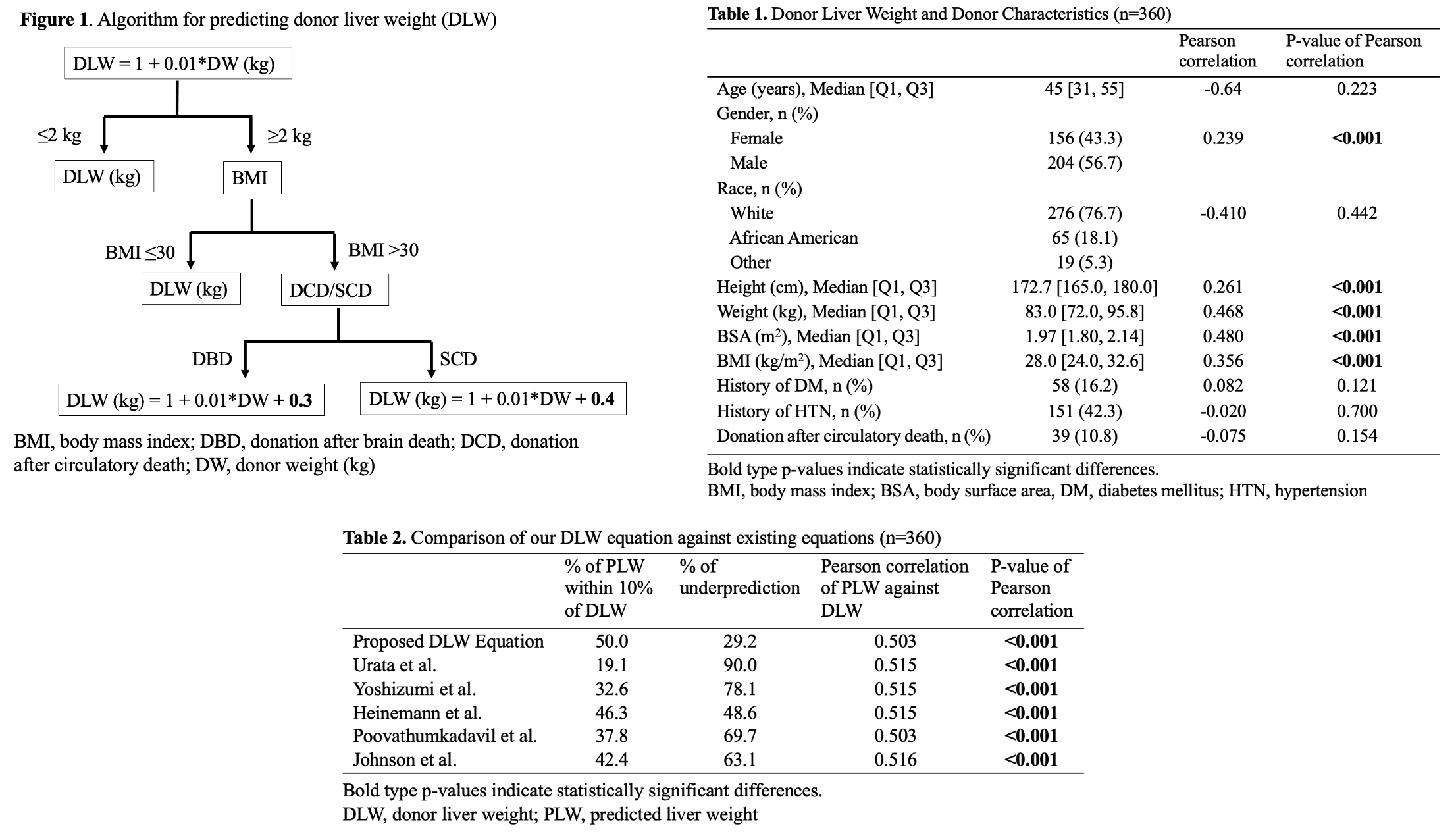Size to Fit: A Simple Formula to Predict Donor Liver Weight in Deceased Donor Liver Transplant
A. Mohamed1, J. Cui2, T. Kitajima1, T. Shamaa1, T. Ivanics1, I. Godana3, A. Yorks2, S. Shimada1, B. Madek1, M. Rizzari1, A. Yoshida1, M. Abouljoud1, S. Nagai1, K. Collins1
1Henry Ford Transplant Institute, Detroit, MI, 2Wayne State University School of Medicine, Detroit, MI, 3General Surgery, McLaren, Lansing, MI
Meeting: 2022 American Transplant Congress
Abstract number: 887
Keywords: Allocation, Liver, Organ Selection/Allocation, Weight
Topic: Clinical Science » Liver » 59 - Liver: Expanding the Donor Pool* (Liver: MELD Allocation / Donor Issues)
Session Information
Session Name: Liver: Expanding the Donor Pool* (Liver: MELD Allocation / Donor Issues)
Session Type: Poster Abstract
Date: Saturday, June 4, 2022
Session Time: 5:30pm-7:00pm
 Presentation Time: 5:30pm-7:00pm
Presentation Time: 5:30pm-7:00pm
Location: Hynes Halls C & D
*Purpose: Estimated donor liver volume (DLV) prediction equations are widely published. However, they often are complex and underpredict DLV, particularly in non-ideal body weight donors. There is a need for accurate estimation for DLV to optimize donor-recipient matching as volumetrics/imaging are often not available to assist with decision making. Furthermore, there is no standard for measuring donor size at time of organ procurement. Underestimation of DLV can result in organ turndown or may complicate implantation.
*Methods: A retrospective analysis was completed using the databases from a single transplant center and UNOS. Adult deceased donor whole liver grafts between 2011 and 2021 were included. Donor liver weight (DLW) was measured after procurement, before bench preparation. 540 grafts met inclusion criteria and had DLW recorded. Patients were randomized; 360 (2/3) were used to create the equation, and 180 (1/3) were used to internally validate. Using step-wise multivariate linear regression, the association between DLW and donor characteristics was identified (Table 1). Comparative analyses against existing formulas were also done.
*Results: A statistically significant regression formula was obtained: DLW (kg) = 1 + 0.01*DW (kg) (r=0.468, p<0.001). Internal validation against 180 patients was also found to be statistically significant (r=0.574, p<0.001). A difference of +/-10% from the actual DLW was deemed clinically acceptable. The initial model underpredicted DLW when predicted LW ≥2kg and BMI >30. Donation type (DCD vs SCD) in this population was also found to be a factor. DCD donors underpredicted by a median of 0.32kg [0.11, 0.50] and SCD donors by a median of 0.20kg [0.07, 0.37]. To mitigate underpredictions without adding much variation from the DLW, corrective factors of 0.4 and 0.3 were added to DCD and SCD donors, respectively (Figure 1). With application of the corrective factors, 50% of grafts fell within 10% of DLW using our formula. These results are comparable to 5 existing formulas in their accepted DLW range and Pearson correlations. Underprediction rate was 29.2%, which outperforms existing models (Table 2).
*Conclusions: In an era where many donors fall outside the ideal body weight, the proposed DLW prediction equation has increased simplicity and lower underprediction rates. This could allow for improved donor-recipient size matching.
To cite this abstract in AMA style:
Mohamed A, Cui J, Kitajima T, Shamaa T, Ivanics T, Godana I, Yorks A, Shimada S, Madek B, Rizzari M, Yoshida A, Abouljoud M, Nagai S, Collins K. Size to Fit: A Simple Formula to Predict Donor Liver Weight in Deceased Donor Liver Transplant [abstract]. Am J Transplant. 2022; 22 (suppl 3). https://atcmeetingabstracts.com/abstract/size-to-fit-a-simple-formula-to-predict-donor-liver-weight-in-deceased-donor-liver-transplant/. Accessed January 8, 2026.« Back to 2022 American Transplant Congress

